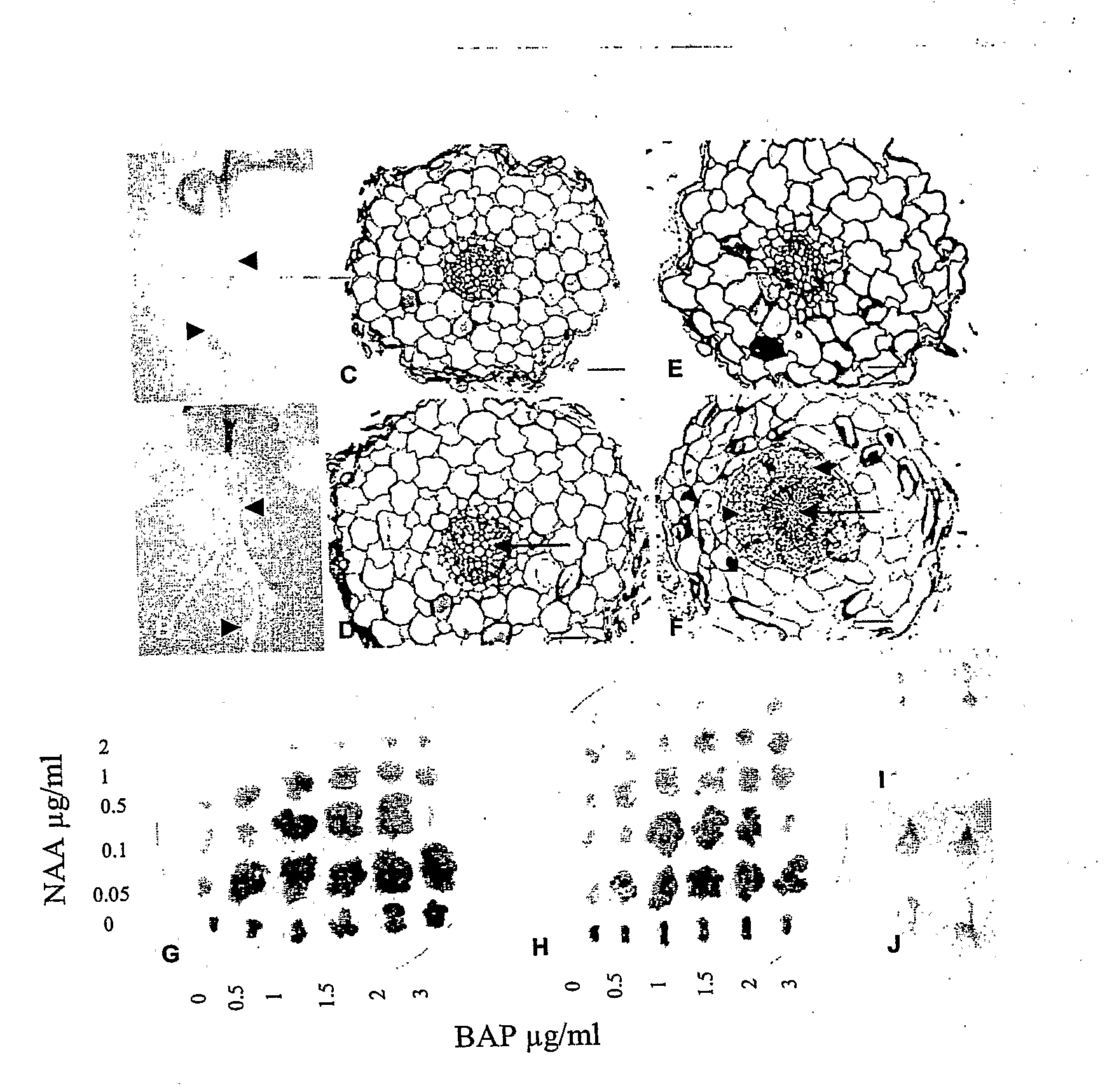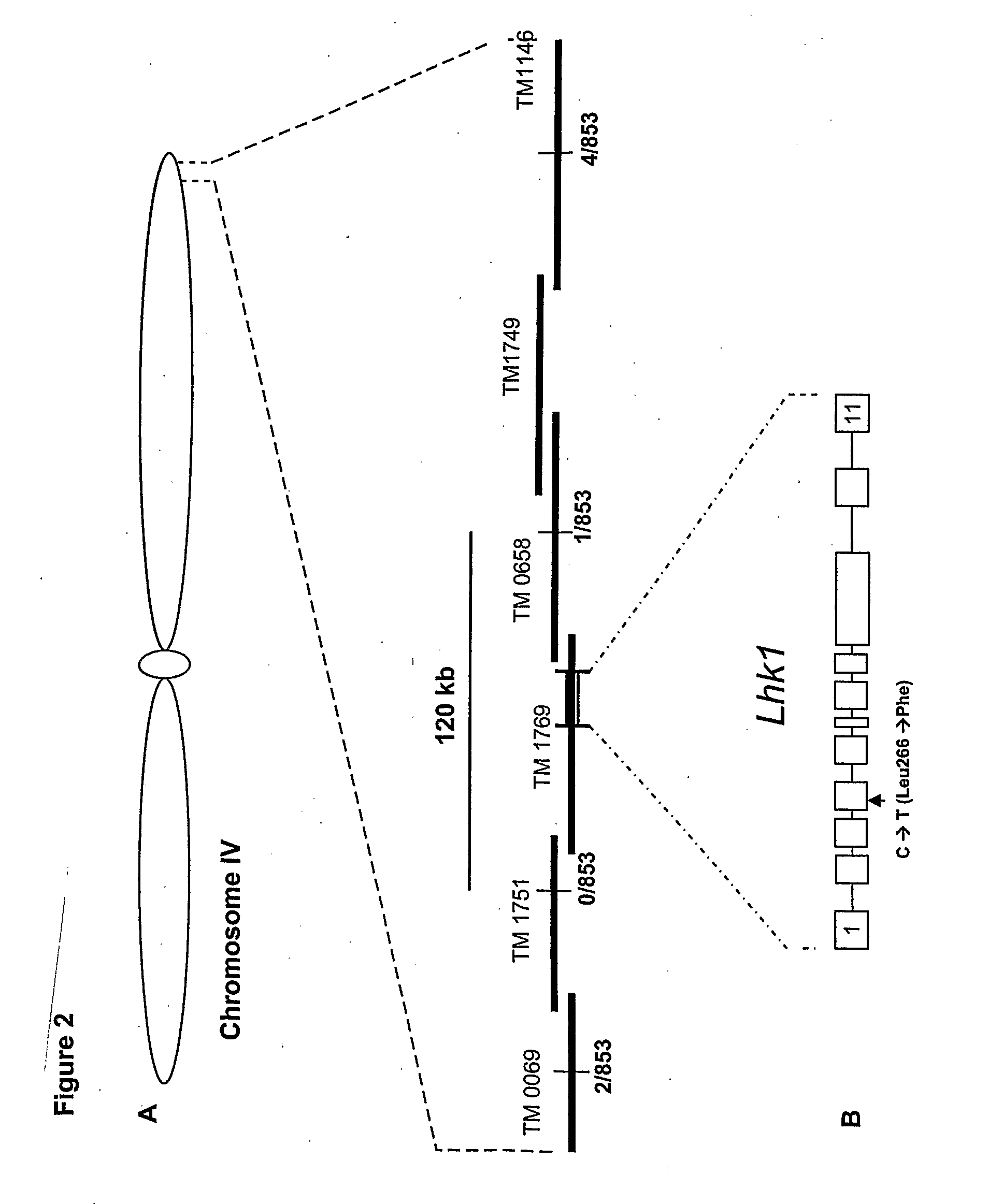Mutant histidine kinase that confers spontaneous nodulation in plants
a histidine kinase and plant technology, applied in the direction of angiosperm/flowering plant, pteridophytes, enzymes, etc., can solve the problem of general limited growth of agricultural crops
- Summary
- Abstract
- Description
- Claims
- Application Information
AI Technical Summary
Benefits of technology
Problems solved by technology
Method used
Image
Examples
example 1
Positional Cloning and Identification of the Mutant snf-2 Gene in Lotus japonicus
[0041]Lotus mutants (snf2-1 and snf2-2) having a spontaneous nodulation phenotype, originates from an EMS screen of Lotus japonicus ecotype Gifu seeds. The mutant snf-2 gene in Lotus japonicus, giving rise to spontaneous nodulation, has been localized on the long arm of chromosome IV, approximately 1 cM from the end, at a locus named Lhk1.
[0042]The location of the snf2 gene was determined by fine mapping using microsatellite markers (TM markers) and single nucleotide polymorphic markers developed from BAC or TAC clones anchored to the genetic map of the Lhk1 region. Mapping was performed on an F2 population established from a cross between Lotus japonicus ecotypes Miyakojima and MG-20. The fine map was used to build a physical TAC / BAC contig comprising six BAC / TAC clones from MG20 that were assembled to cover the Lhk1 region between the two flanking markers TM1146 and TM0069 (FIG. 2). Since snf2 is a d...
example 2
Cloning and Identification of the Lhk1 cDNA Corresponding to the Transcript of the Wild Type Lhk1 Gene in Lotus japonicus
[0043]A full-length Lhk1 cDNA (3568 bp) was isolated from a λ ZAPII cDNA library prepared from mRNA isolated from M. loti inoculated Lotus japonicus roots. The Lhk1 cDNA was sequenced [SEQ ID NO:2], from which the transcription start site was determined to lie at least 137 nucleotides upstream of the start codon and the coding sequence was followed by a 3′ untranslated region of approximately 445 nucleotides. Alignment of genomic and cDNA sequences defined a primary structure of Lhk1 consisting of 11 exons (FIG. 2B). The nucleotide sequence of the mutant snf2 allele of the Lhk1 cDNA is designated SEQ ID NO:5.
Example 3
Expression of the snf2 Allele in Wild Type Lotus Roots Confers a Spontaneous Nodulation Phenotype
[0044]Transgenic expression of the wild type or mutant snf2 allele in wild type Lotus roots was performed in order to confirm in planta the genetic basis...
example 3
Lotus LHK1 is a Member of the Cytokinin Receptor Family
[0045]Annotation of the Lhk1 cDNA clone reveals an open reading frame of 2979 nucleotides that is predicted to encode a cytokinin receptor protein (LHK1) consisting of 993 amino acids with a predicted mass of 110 kD (FIG. 4). At the N-terminus, two membrane spanning segments are located between amino acids 37 and 57 and between amino acids 328 and 357. Located between these segments are motifs characteristic for the cyclases / histidine kinases associated sensory extracellular (CHASE) domain. This predicted extracellular domain is followed by a putative intracellular histidine kinase between amino acids 379 and 693 and a receiver domain between amino acids 852 and 985. These domains are characteristic for two-component regulatory systems operating through a phospho-relay.
[0046]Comparative analysis defines the Lotus LHK1 protein as a member of the cytokinin receptor family which includes proteins from Medicago truncatula, Arabidops...
PUM
| Property | Measurement | Unit |
|---|---|---|
| temperature | aaaaa | aaaaa |
| concentrations | aaaaa | aaaaa |
| time | aaaaa | aaaaa |
Abstract
Description
Claims
Application Information
 Login to View More
Login to View More - R&D
- Intellectual Property
- Life Sciences
- Materials
- Tech Scout
- Unparalleled Data Quality
- Higher Quality Content
- 60% Fewer Hallucinations
Browse by: Latest US Patents, China's latest patents, Technical Efficacy Thesaurus, Application Domain, Technology Topic, Popular Technical Reports.
© 2025 PatSnap. All rights reserved.Legal|Privacy policy|Modern Slavery Act Transparency Statement|Sitemap|About US| Contact US: help@patsnap.com



